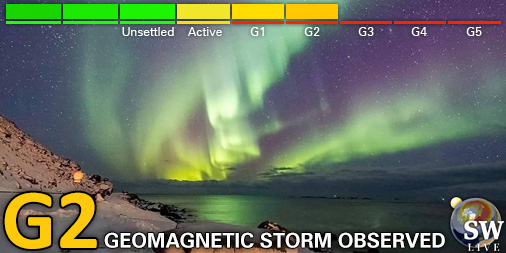Viewing archive of Thursday, 2 April 2015
Daily bulletin on solar and geomagnetic activity from the SIDC
Issued: 2015 Apr 02 1239 UTC
SIDC Forecast
Solar flares
Eruptive (C-class flares expected, probability >=50%)
Geomagnetism
Minor storm expected (A>=30 or K=5)
Solar protons
Quiet
| 10cm flux | Ap | |
|---|---|---|
| 02 Apr 2015 | 122 | 012 |
| 03 Apr 2015 | 121 | 028 |
| 04 Apr 2015 | 124 | 010 |
Bulletin
Five sunspot groups were reported by NOAA today. However, the only C-class flare observed during the past 24 hours (C1.3 flare peaking at 05:34 UT today) occurred in the active region just behind the east solar limb. More C-class flares are expected from this active region. The C1.3 flare was associated with a partial halo CME (angular width around 150 degrees). It is a far side limb event, so it will not arrive at the Earth and will have no geomagnetic consequences. The Earth is currently inside a slow solar wind flow following the passage through the ICME on March 31 - April 1. The interplanetary magnetic field magnitude is still elevated (around 7-8 nT), but a relatively low solar wind speed (around 450 km/s) makes sure that the geomagnetic situation will most probably remain on the quiet to unsettled level in the coming hours. Later today we expect the arrival of a fast flow from a trans-equatorial coronal hole that reached the solar central meridian late on March 30, possibly resulting in a geomagnetic disturbance up to the minor storm level (K = 5).
Today's estimated international sunspot number (ISN): 025, based on 14 stations.Solar indices for 01 Apr 2015
| Wolf number Catania | /// |
| 10cm solar flux | 124 |
| AK Chambon La Forêt | 015 |
| AK Wingst | 009 |
| Estimated Ap | 010 |
| Estimated international sunspot number | 028 - Based on 20 stations |
Noticeable events summary
| Day | Begin | Max | End | Loc | Strength | OP | 10cm | Catania/NOAA | Radio burst types | |
|---|---|---|---|---|---|---|---|---|---|---|
| None | ||||||||||
Provided by the Solar Influences Data analysis Center© - SIDC - Processed by SpaceWeatherLive
All times in UTC
Current data suggests there is a moderate possibility for aurora to appear at the following middle latitude regions in the near future
YakutskCurrent data suggests there is a slight possibility for aurora to appear at the following low latitude regions in the near future
Krasnoyarsk, NovosibirskLatest news
Latest forum messages
Support SpaceWeatherLive.com!
A lot of people come to SpaceWeatherLive to follow the Sun's activity or if there is aurora to be seen, but with more traffic comes higher server costs. Consider a donation if you enjoy SpaceWeatherLive so we can keep the website online!

Latest alerts
15:30 UTC - Geomagnetic activity
Minor G1 geomagnetic storm (Kp5) Threshold Reached: 15:20 UTC
14:30 UTC - Geomagnetic activity
Strong G3 geomagnetic storm (Kp7) Threshold Reached: 14:18 UTC
13:30 UTC - Geomagnetic activity
Moderate G2 geomagnetic storm (Kp6) Threshold Reached: 13:21 UTC
13:18 UTC - Hemispheric Power Index
The OVATION model predicts the Hemispheric Power Index to reach 125GW at 14:01 UTC
13:15 UTC - Geomagnetic activity
Minor G1 geomagnetic storm (Kp5) Threshold Reached: 13:13 UTC
Space weather facts
| Last X-flare | 2025/03/28 | X1.1 |
| Last M-flare | 2025/04/15 | M1.2 |
| Last geomagnetic storm | 2025/04/15 | Kp6+ (G2) |
| Spotless days | |
|---|---|
| Last spotless day | 2022/06/08 |
| Monthly mean Sunspot Number | |
|---|---|
| March 2025 | 134.2 -20.4 |
| April 2025 | 124.1 -10.1 |
| Last 30 days | 124.7 -16.6 |






